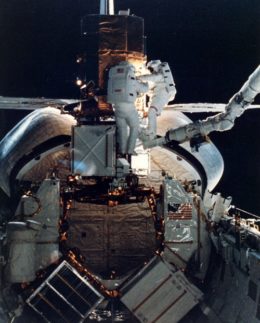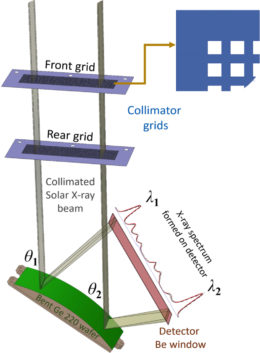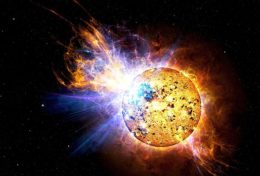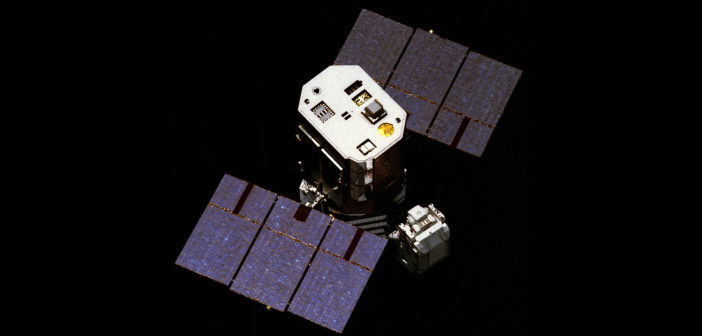In 1984, a rescue mission took place in space — ultimately saving a spacecraft that went on to make some of the most detailed observations we have of solar flares during a highly active solar cycle. Now, more than three decades later and thanks to some clever recalibration, we’re still reaping the rewards.
A Dramatic Rescue

STS-41-C astronauts George Nelson (right) and James van Hoften (left) repair the SolarMax satellite in the Challenger shuttle’s open payload bay. [NASA]
The attempted retrieval process was anything but smooth. The astronauts’ jetpack-powered space-walk rendezvous with SolarMax (pictured above) — during which they intended to dock with the satellite and slow its gentle rotation — failed, with the spacecraft entering an uncontrolled tumble after an astronaut tried to slow it by grasping a solar panel. Unable to point its panels at the Sun, SolarMax’s batteries started to drain, and the astronauts were forced to retreat to the shuttle to regroup.
Ultimately, the team managed a last-minute rescue, retrieving the satellite using the shuttle’s robotic grappling arm and maneuvering it into the payload bay. After performing a multi-hour repair, the victorious crew returned SolarMax to orbit — and their rescue extended the mission’s lifetime by another five years.
Curved Crystals to Gather X-rays
What was SolarMax, and why was it worth repairing? The satellite carried an array of instruments all designed to observe the flaring Sun at ultraviolet, X-ray, and gamma-ray wavelengths.

Schematic of the Bent Crystal Spectrometer shows how a curved crystal was used to produce X-ray spectra. [Sylwester et al. 2020]
One of the valuable instruments on SolarMax was the Bent Crystal Spectrometer (BCS), an instrument that pioneered the concept of using curved crystals in space instrumentation to produce X-ray spectra. The spectral resolution of the BCS remains the highest of any long-operating solar X-ray spectrometer, and the instrument’s observations provide valuable insight into the properties of the hot plasma in solar flares.
Now, in a new study led by Janusz Sylwester (Space Research Center, Polish Academy of Sciences), a team of scientists has conducted a valuable recalibration of BCS spectra.
Looking Beyond the Sun
By examining data produced during the scan of a solar flare in November 1980, Sylwester and collaborators are able to identify and quantify the effect of small deformations in the crystal curvature of one of the channels. Accounting for these deformations resolves a long-standing mystery of certain anomalies in the ratios of emission lines in BCS data.

Artist’s impression of a record-setting stellar flare from the nearby star EV Lacertae. [Casey Reed/NASA]
With revitalization efforts like this, observations from BCS thus continue to be valuable many years after the mission end — well justifying the daring in-orbit rescue of SolarMax.
Citation
“A Unique Resource for Solar Flare Diagnostic Studies: the SMM Bent Crystal Spectrometer,” J. Sylwester et al 2020 ApJ 894 137. doi:10.3847/1538-4357/ab86ba


1 Comment
Pingback: From AAS NOVA: “Bent Crystals and Solar Flares” | sciencesprings